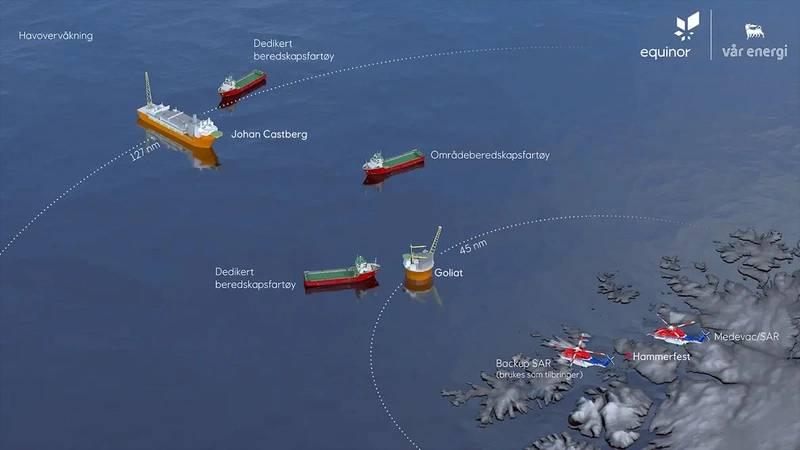Equinor Strengthens Preparedness in the Barents Sea

The Norwegian Ocean Industry Authority has approved the establishment of the area preparedness in the Barents Sea, which will be operative from January 1st, 2025. (Illustration: Equinor/Vår energi)
Equinor will establish and operate a new area-wide emergency preparedness solution for the southwestern Barents Sea. The solution will add new resources, expertise, and capabilities to strengthen safety and emergency preparedness in this ocean area.
The Norwegian state-owned Equinor strengthens preparedness in the Barents Sea through cooperation with Vår Energi, operator of Goliat, initiated by the Barents Sea Operation Cooperation (BASOP).
The Norwegian Ocean Industry Authority has given its consent to the establishment of the area-wide emergency preparedness system, which will be operational from January 1st, 2025.
"Safety is our number one priority, and we must have a good emergency preparedness system in place wherever we operate. Together with the other operators, the authorities, and the supply industry, we have, through fifty years, developed the preparedness for the fields in the North Sea and in the Norwegian Sea. With Johan Castberg coming on stream towards the end of the year and increased activity in the north, we are now establishing an area-wide emergency preparedness system in the Barents Sea in the Barents Sea," says Grete B. Haaland, Equinor’s senior vice president for Exploration & Production North.

Grete B. Haaland, Equinor’s senior vice president for Exploration & Production North. (Photo: Equinor)
Increased security
The emergency preparedness in the Barents Sea is already good with the solution that Vår Energi has established for the Goliat field.
The new area-wide emergency preparedness system will further strengthen the emergency preparedness and is dimensioned to deal with emergency preparedness incidents in an ocean area characterized by long distances, harsh weather conditions and important natural resources. The solution enables interaction and sharing of common resources, and other companies may join later.
"This will help improve safety and strengthened emergency preparedness for the fisheries and other users of the sea in this area. We will, among other things, build a new emergency response and rescue vessel (ERRV) that will make a difference. We have worked closely with the fishing fleet on emergency preparedness in the Barents Sea since the start-up of Goliat, where we are a licensee," Haaland adds.
The area-wide emergency preparedness system for the southwestern Barents Sea includes:
- One "all weather search and rescue" (AWSAR) helicopter of the type S-92, stationed at Hammerfest Airport.
- Three emergency response and rescue vessels with standing oil spill response capabilities (NOFO standard). One vessel dedicated to Goliat and one dedicated to Johan Castberg, in addition to one joint emergency response and rescue vessel.
- Equinor plans to build a new emergency response and rescue vessel that will feature IMR (inspection, maintenance and repair) capabilities to contribute to safety, short response times and inspections
- In the long term, faster response times for SAR and improved medical preparedness in the area.
- Continuous ocean and ice monitoring.
- Monitoring and follow-up from Equinor's operations centre in Bergen with physical infrastructure, digital systems and round-the-clock staffing.
- Increased interaction, central coordination and mutual agreement between the companies that are part of the area-wide emergency preparedness.
- In addition oil spill response equipment at the NOFO base in Hammerfest may be mobilised for supply vessels (PSVs).


